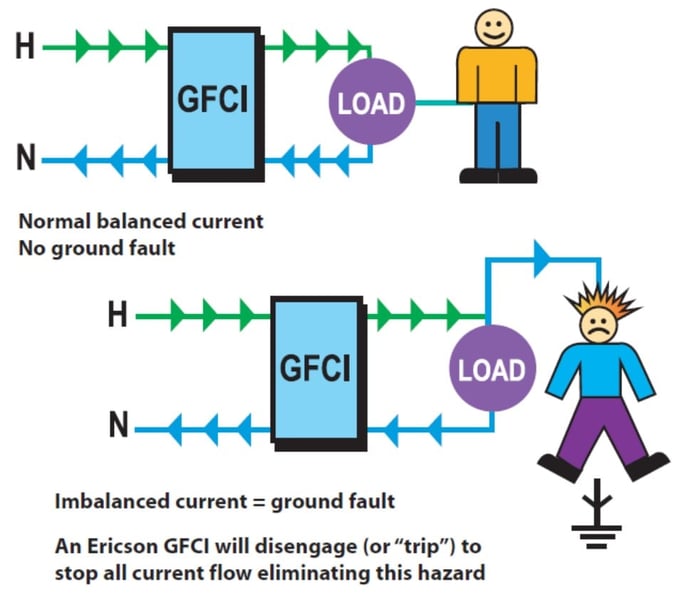How does a Ground Fault Circuit Interrupter (GFCI) work?
A GFCI is a fast acting circuit opening or breaking device that stops the flow of dangerous current in the event of electrical shock
The GFCI uses precise electronic circuitry to sense the imbalance of the load from the hot and neutral lines. In other words, the GFCI monitors the current flow leaving and coming on both the hot and neutral lines of the circuit. In the event of an imbalance, the GFCI immediately releases the holding relay and breaks both the hot and neutral lines simultaneously there by stopping the current flow and preventing human injury. The GFCI is not a circuit breaker in that it does not sense the overall load and disconnect in the event of full or excess balanced current flow. The imbalance in current flow can be very small to “trip” a GFCI. Whenever the current flow “going” and “returning” differs more than 5 mA ( +/-1 mA), the GFCI opens the relay stopping the current flow.

Beware of “Open Neutrals” and “Reverse Phasing”…
Normally, GFCI receptacles (like those found in your bathroom) can sense ground-faults. However, if the line-side neutral conductor is opened or lifted at a panel, the circuitry in the GFCI receptacles will not have the necessary complete circuit path from which to operate. That means that GFCI is no longer capable of sensing and disengaging. This is called an “open neutral.” Anyone using the receptacles protected by the disabled GFCI will not have GFCI protection. And if a faulted tool is connected to the now-unprotected receptacle, the user will be exposed to a shock or electrocution hazard.
| Milliamperes | Effect on Average Human |
| 1 or less | Causes no sensation - not felt, is at threshold of perception |
| 1 to 8 | Sensation of shock. Not painful. Individual can let go at will, as muscular control is not lost. (5mA is accepted as maximum harmless current intensity.) |
| Milliamperes | Effect on Average Human |
| 8 to 15 | Painful shock. Individual can let go at will, as muscular control is not lost. |
| 16 to 20 | Painful. Severe muscular contractions. Breathing is difficult. |
| 21 to 99 | Painful. Severe muscular contractions. Breathing is difficult. |
| 100 to 200 | Ventricular fibrillation. (A heart condition that may result) Disrupts or changes rhythm of the heart. |
| 200 & over | Severe burns. Severe muscular contractions - so severe that chest muscles clamp heart and stop it during duration of shock. (This prevents ventricular fibrillation.) |
